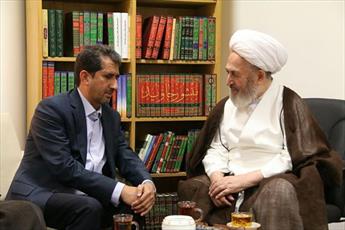By: Martyr Dr. Muhammad Mufatteh
Hawzah News Agency- In every city the Muslims entered, their first objective was to establish mosques and schools. Therefore, in all the Islamic cities, schools were established, but in Islamic history, some schools were mentioned more frequently and were centers of research in various scientific subjects. The first and most important of these schools is Baghdad Academy, which is also known as Baitul-Hikmah (House of Wisdom).
This scientific center was established by Harun al-Rashid, the Abbasid Caliph, and completed by his successor, Ma'amun, collected literature and was a center of attraction to interpreters and researchers from many countries. The various scientific theories and practices developed in Baghdad Academy found an atmosphere conducive to scientific research.
Ma'amun greatly developed and assisted in the expansion of the House of Wisdom and spent three hundred thousand gold coins in translating Greek books. One of the conditions of the peace convention between Ma'amun and the Emperor of Rome was that the Roman Emperor ceded the Constantinople libraries to Ma'amun. Ptolemy's book on astronomy was among these books which Ma'amun ordered for translation.
The translators of the Baghdad Academy were a group of knowledgeable and educated men from Iran, Syria, and India and most of them were Syriac, who were very learned in Greek science and philosophy. Some of the famous men were from a family called Bukhtishoou, the son of the Syriac Bukhtishoou, who was Mansour's physician, and some were Nestorian.
There were also translators from the family of Hanin Ibn Ishagh, Karkhi, Sabet Harani Sa'ebi. The most famous translators in Persian and Hindi languages included: Ibn al-Muqaffa, the astrologist family of Nobakht and Ali-Ibn Ziad Tamimi, (who translated the books of Zeyjol-Shahriar), Hassan Ibn Sahl and Belazari Ahmad Ibn Yahya (the chief director of Bararnakah Hospital).
In other parts of the Islamic world, scientific centers similar to the House of Wisdom were established, particularly after the downfall of the Caliphate and the resultant independence of small and large countries. This political separation was an important factor for scientific and nonscientific competition among different courts in various countries and each and every one of them tried to establish centers like the one in Baghdad. As a result of this competition, many centers were established in cities such as Sarnarghand, Marv, Harat, Tous, Nayshabur, Rey, Isfahan, Shiraz, Damascus, Quds (Jerusalem), Cairo, Ghirvan, Fez, Eshpilieh, Gharnateh, and elsewhere.
Hajj as a Scientific Congress for Islamic Schools
The religious duty of Hajj was an opportunity for great Muslim scientists from different schools to gather in Mecca and meet each other. In this way, they became enthusiastic about visiting each other's schools and educational centers in order to discuss and exchange their ideas and inform each other of their discoveries. Very often, after performing their pilgrimage, Muslim scientists stayed in cities like Andalusia or Maghrib1 in Egypt, held discussions with their colleagues and took notes from the scriptures and books available. Through this common scientific language, knowledge spread in all four corners of the Islamic world with tremendous speed. Due to these relations between educational centers, they progressed towards a brighter civilization.
Miracles of Muslims
As a result of this cultural and educational relation a new scientific civilization was created for the whole world and it all came into existence in less than two centuries and spread all over the world.
Researchers and historians viewed this phenomenon with surprise and they called it the "Muslim Miracle." In other words, they confessed to the creative power of this movement and admitted it was greater than the movements which had taken place before the thirteenth Christian century. In a short time, the Muslims achieved amazing success in different subjects which we shall briefly mention: Islamic scientists studied algebra and trigonometry on the basis that the Indians and the Greeks established and they revealed them and expanded them. In addition, they also conducted some studies in astronomy.
They have criticized Ptolemy's delegation, which paved the way for scientific movements in the sixteenth century. Muslims contributed new medical observances, founded new methods of chemistry, and introduced new information regarding measurements, weights and atmospherical effects in physics.
Their research in geography included the whole world at that time, and they wrote many useful books about civilized countries and also introduced a new way to analyze the philosophy of history.
End.



Your Comment